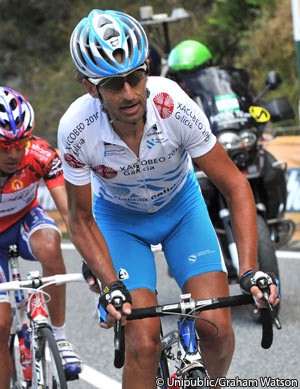Rider hoping to ride Vuelta a Espana
 Three months after the UCI requested the Spanish federation RFEC to open disciplinary proceedings against Ezequiel Mosquera, the Spanish Anti Doping Agency (AEA, Agencia Española Antidopaje) has given its support to the rider.
Three months after the UCI requested the Spanish federation RFEC to open disciplinary proceedings against Ezequiel Mosquera, the Spanish Anti Doping Agency (AEA, Agencia Española Antidopaje) has given its support to the rider.
According to BiciCiclismo, the agency has said that there is “no possibility of defining the route of administration” of the substance hydroxyethyl. It was detected in Mosquera’s system on September 16th, one day before the end of the race, when he won the Bola del Mundo stage and secured his final second place overall.
Under WADA rules, the substance is considered a masking agent but banned only if it is injected. The AEA says that it is not possible to distinguish how it got into his body. Mosquera has repeatedly denied taking the substance intraveniously, but has not explained why it was in his system.
The AEA also asked if the substance improved performance. It accepted that it is a banned masking agent, but states that no doping substance was found in the urine of the rider. It also pondered if it could be transmitted via food, and accepts the defence’s claim that this could be the case.
The AEA’s statement that no banned substance was found in his urine appears misleading; the purpose of a masking agent is to hide traces of substances which would otherwise be detected in tests, or to speed their excretion prior to a test.
His then-Xacobeo Galicia team-mate David Garcia also tested positive for hydroxyethyl starch during the Vuelta. In his case, traces of EPO were later found.
In a statement released in March, Mosquera called on the UCI to clear him. “Scientific studies show that Hydroxyethyl starch doesn’t enable the improvement of sporting performance. Hydroxyethyl starch isn’t forbidden in case of intramuscular or oral intake; it is only not authorized by intravenous intake.
“Unlike what is generally assumed, Hydroxyethyl starch doesn’t hide doping substances,” he claimed. “This was proved through other cases, where laboratories could detect Hydroxyethyl starch together with EPO.” He claimed that the WADA-accredited laboratory in Köln examined his samples for EPO. “They looked for it and they concluded it was not in my body,” he said.
Mosquera’s contention that the detection of a banned substance with a masking agent proves that they do not hide the substance is one which would be contested by some scientific experts. Masking agents such as diuretics can increase the rate of urine excretion, thus helping a banned substance be expelled from the system sooner than usual. This narrows the time period when it can be detected, but doesn’t completely eliminate it.
EPO is only detectable for a limited period of time. Furthermore, hydroxyethyl has been described as a blood plasma volume expander which can be used to disguise the increase in hematocrit and other markers which occur with the use of EPO and other related substances.
These increases are amongst the signs used by the UCI’s biological passport to pinpoint suspicious activity.
This week Mosquera’s Vacansoleil team listed him as part of its provisional selection for the Vuelta a España. It stated however that he would not be permitted to ride the race unless he was cleared beforehand.
The AEA’s conclusion appears to suggest that he will be cleared by the Spanish federation RFEC. In that case, the UCI and WADA could appeal the verdict to the Court of Arbitration for Sport, as they have done in the Alberto Contador case.